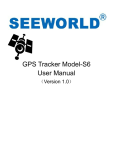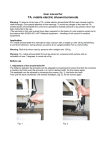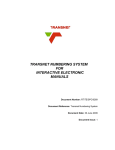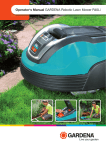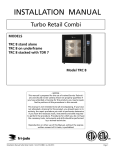Download User`s Manual Second Edition
Transcript
Towing Checklist Hitching · · · · · Hitch is sufficient to tow trailer and load Hitch is properly attached to tow vehicle Safety chains and brake cable are properly attached (cross safety chains under tongue of trailer) All tires have correct pressure All lights are connected and working User’s Manual Loading · · · Load is properly distributed on trailer Load does not exceed maximum gross trailer weight Load is securely strapped to trailer Towing · · · · Do not exceed 60 mph / 97 km/h Check connections and tire pressure at each stop Slow down for hazardous conditions Allow extra distance for following and passing other vehicles Genie North America Phone 425.881.1800 Toll Free 800.536.1800 Fax 425.883.3475 Keep this manual with you for reference while on the road. Second Edition Second Printing Part No. 82288 User’s Manual Important Read, understand and obey all safety rules and instructions before using this trailer. Follow the procedures in this manual carefully when hitching and loading the trailer, and keep this manual with you for reference while on the road. Contents Page Towing Hazards ................................... 1 Hitch Requirements .............................. 2 Before Hitching .................................... 3 Hitching the Trailer ............................... 4 Loading the Trailer ............................... 5 Loading Instructions ............................. 6 Towing Information ............................... 8 Backing ................................................ 9 Glossary ............................................ 10 Reporting Safety Defects ................... 11 Copyright © 2002 by Genie Industries Second Edition: Second Printing, July 2002 "Genie" is a Registered Trademark of Genie Industries in the USA and many other countries. Printed on recycled paper Printed in U.S.A. Part No. 82288 User’s Manual Warning Failure to obey the instructions and safety rules in this manual could result in death or serious injury. Towing Hazards Read, understand and obey all of your tow vehicle manufacturer’s recommendations, warnings and instructions before towing this trailer. Make sure your tow vehicle is properly maintained and capable of towing the trailer and its load. Do not overload your tow vehicle. Observe the manufacturer’s Gross Vehicle Weight Rating (GVWR). Be sure the trailer is properly loaded and the load is secure. Be sure the safety chains are securely attached to the tow vehicle before towing. Be sure that all vehicle and trailer lights are operational. Do not ride in the trailer. Do not exceed the maximum towing speed: 60 mph / 97 km/h. Part No. 82288 1 User’s Manual Hitch Requirements Be sure your hitch is adequate to tow the trailer and its load. Your hitch must attach to the underframe of the tow vehicle and meet the capacity requirements for your trailer model. GT-5 Class III trailer hitch with a carrying capacity of 5000 lbs / 2268 kg 2-inch hitch ball GT-10 Class IV trailer hitch with a carrying capacity of 10,000 lbs / 4636 kg 25/16-inch hitch ball 2 Part No. 82288 User’s Manual Before Hitching Be sure all lights, mirrors and hitch components conform to federal and local regulations. Be sure the trailer tires are properly inflated. Be sure the hitch is properly and securely attached to your tow vehicle. Be sure the following decals are in place and legible: Part No. Desc. Quantity 62707 Maximum Towing Speed 1 82182 Maximum Capacity, GT-10 1 82256 Tire Specifications 2 82186 Refer to loading. . . 2 82255 Loading Safety 1 82284 Maximum Capacity, GT-5 1 82184 Trailer Center (models with sides) 4 Trailer Center (models without sides) 2 82184 Part No. 82288 3 User’s Manual Hitching Trailer to Tow Vehicle 1 Raise the tongue of the trailer by turning the jack handle. 2 Position the hitch ball of the tow vehicle directly under the coupler on the trailer. 3 Open the latch on the coupler. 4 Turn the jack handle and lower the coupler onto the hitch ball. 5 Close the latch on the coupler and secure the lynch pin. 6 Attach the safety chains and the safety brake chain to the vehicle. Cross the safety chains under the tongue. This will create a cradle to catch the tongue of the trailer if it becomes disconnected from the tow vehicle. 7 Pull the jack release pin and rotate the tongue jack to the stowed position. Insert the pin to secure the jack. 8 Connect and test the trailer lights. Note: When attaching the safety chains, brake cable and lights, allow some slack so the vehicle can make turns. Do not let chains and cables drag on the ground. 4 Part No. 82288 User’s Manual Loading the Trailer Observe and Obey: Collision hazard. Failure to properly load the trailer could cause an accident resulting in death or serious injury. Do not exceed the trailer’s maximum (fully loaded) gross weight rating. Maximum Gross Trailer Weight GT-5 GT-10 5000 lbs / 2268 kg 10,000 lbs / 4636 kg Refer to the serial plate for your trailer’s empty weight. The tongue weight of the trailer should be 10% of the loaded trailer weight. Maximum Tongue Weight GT-5 GT-10 Part No. 82288 500 lbs / 227 kg 1000 lbs / 454 kg 5 User’s Manual LOADING THE TRAILER Do not exceed the Gross Combined Weight Rating of the tow vehicle and the trailer (GCWR) as specified by the tow vehicle manufacturer. This is the maximum loaded weight the tow vehicle can tow. Do not overload your tow vehicle. Check the manufacturer’s Gross Vehicle Weight Rating (GVWR). The total weight of the tow vehicle, its occupants, cargo, and the tongue weight of the trailer must not exceed the GVWR. Be sure the load is properly centered on the trailer deck. Use the center mark on each side of the trailer to properly center the load. Loading Instructions 1 Pull the pins and lower the ramps on the back of the trailer. 2 Adjust the ramps to accomodate the axle width of the load. 3 Models with sides: Lift the door latch handles and open the doors. Secure the doors in the open position. 6 Part No. 82288 User’s Manual 4 Place 50% of the weight of the load on the front half of the trailer deck and 50% on the back half. Refer to the center mark on each side of the trailer. 5 Adjust the load to achieve the proper tongue weight . 6 Loose items on the trailer (lumber, bricks, etc.) must be contained and properly secured to the trailer. 7 Secure the load. Use binders or straps of sufficient quantity and strength to secure the load to the trailer. Collision hazard. Failure to properly secure the load in the trailer could cause an accident resulting in death or serious injury. 8 Models with sides: Close and latch the doors. 9 Raise the ramps and lock them into place. Note: Confirm vehicle and trailer weights at a public scale. Part No. 82288 7 User’s Manual Towing Information Driving a vehicle that is pulling a trailer is different from driving a vehicle alone. Read the following instructions carefully. Use the checklist on the back cover of this manual before towing and while on the road. Inspect all connections at each stop. All tires must be properly inflated. Find the recommended cold tire pressures on the tire sidewall or trailer decal. Do not overinflate the tires. Tire pressures go up during driving. Checking the tire pressure when the tires are warm will give you an inaccurate pressure reading. Increase the distance between your vehicle and the vehicle in front of you to twice the normal following distance when towing a trailer. Allow more following distance in adverse weather. Slow down for downgrades and shift your transmission into a lower gear. Slow down for curves, hazardous road conditions, freeway exits, and when driving in adverse weather. When passing other vehicles, be sure to leave enough room for the extra length of the trailer. You will need to go much farther beyond the passed vehicle before you can return to your lane. When turning with a trailer, avoid jerky or sudden movements. 8 Part No. 82288 User’s Manual Heavy winds, excessive speed, load shifting or passing vehicles can cause the trailer to sway while driving. If this occurs, do not brake, speed up or turn the steering wheel. Turning the steering wheel or applying the brakes can cause the vehicle and trailer to jackknife. Let up on the gas pedal and keep the steering wheel straight. If the vehicle and/or trailer travels off the paved road, hold the steering wheel firmly and let up on the gas pedal. Do not apply the brakes. Do not turn sharply. Slow down to under 25 mph / 40 km/h. Gradually turn the steering wheel to get back on the road. Proceed with caution when entering traffic. Backing Always drive slowly when backing a trailer. Keep your hand on the bottom of the steering wheel. Move your hand to the left to turn the trailer to the left. Move your hand to the right to turn the trailer to the right. If the trailer is not going where you want it to go, or the trailer and vehicle start to jackknife, pull forward to straighten out and start backing again. Part No. 82288 9 User’s Manual Glossary Tongue - the part of the trailer from the trailer bed to the coupler. Coupler - the part of the tongue that covers the hitch ball. Hitch Ball - the ball shaped part of the hitch onto which the coupler attaches. Tongue Weight - the downward weight that the tongue of a fully loaded trailer puts on the hitch ball. Maximum Gross Trailer Weight - the maximum capacity of the trailer plus the weight of the trailer itself. Gross Vehicle Weight Rating (GVWR) - the maximum towable weight of the tow vehicle, its occupants, cargo, and the tongue weight of the trailer, as recommended by the tow vehicle manufacturer. Gross Combined Weight Rating (GCWR) - the combined gross vehicle weight of the tow vehicle and the trailer, as specified by the tow vehicle manufacturer. 10 Part No. 82288 User’s Manual Genie Industries PO Box 97030 Redmond, WA 98073-9730 Reporting Safety Defects If you believe that your vehicle has a defect which could cause a crash or could cause injury or death, you should immediately inform the National Highway Traffic Safety Administration (NHTSA) in addition to Genie Industries. If NHTSA receives similar complaints, it may open an investigation, and if it finds that a safety defect exists in a group of vehicles, it may order a recall and remedy campaign. However, NHTSA cannot become involved in any individual problems between you, your dealer or Genie Industries. To contact NHTSA you may either call the Auto Safety Hotline toll-free at 1-800424-9393 (366-0123 in Washington DC area) or write to: NHTSA U.S. Department of Transportation 400 7th Street SW, (NSA-11) Washington DC 20590 You can also obtain information about motor vehicle safety from the Hotline. Part No. 82288 11













